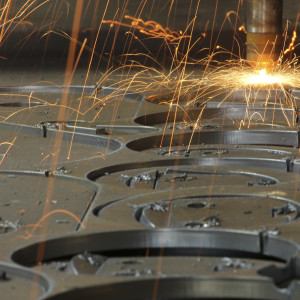What Are Laser Jet Cutting and Waterjet Cutting?
Sheet metal is a very useful, versatile, material that is recyclable, can be used in a wide range of products, and in most cases is considered to be cost-effective. The only real problem with it is that this form of metal can be challenging to work with. All it takes is a sharp knife and a little know-how to carve wood, but if you want to work materials such as steel, aluminum, brass, stainless steel, or bronze you need specialized tools like laser jet cutting equipment. As you might already know, cutting sheet metal can be very challenging and the thicker the sheet, the harder it can be to cut. What you might not know, is that metal can be cut into intricate parts and patterns using with a water or laser jet cutting device. Each of these tools has its own strengths and weaknesses. Waterjet Cutting Think of waterjet cutting in terms of the erosion caused by the continuous motion of a waterfall. Over many decades, the rocks at the top of the waterfall will be worn away. Waterjet cutting works in a similar fashion but at a much higher rate of speed. This type of cutter using strong jets of water containing some form of abrasive, such as an aluminum oxide or garnets to cut sheet metal. The water pressure can be as high as 60,000 psi, one of the main reasons this type of cutter is typically reserved for use with thicker metals that trying to use a laser jet cutter would prove to be impractical. Those shops who opt for a waterjet cutter do so for one of these four reasons:
- They tend to work with thicker materials.
- They can’t use a laser as the heat could cause problems with smaller patterns.
- They work with a wide variety of materials beyond metal, including stone, ceramic, and a variety of reflective metals.
- When using a waterjet cutter, the metal will remain flat throughout the cutting process, laser cutting often requires extra leveling.
Laser Jet Cutters Laser jet cutters offer precise high-speed cutting but has one major drawback, it can only be used to cut metals up to 5/8″ and still maintain any semblance of quality. Today’s machinists use CAD software to send the required information to the computer in order for it to start the cutting process within seconds, making this type of cutting ideal for crafting prototypes. Laser cutting also offers the advantage of scalability, making it the perfect choice for longer production runs in which the only labor involved is loading the machinery and unloading the finished parts. Companies like Additive Manufacturing, LLC often allow production to continue overnight with no one attending the machines. As you can see both types of cutting have their advantages and disadvantages. In order to remain competitive, many machine shops and manufacturing facilities keep both systems in operation to ensure they can handle virtually any type of metal cutting. At Additive Manufacturing, LLC we offer them both to ensure we can meet your needs from rapid prototyping to full production runs. Contact us at (877) 238-7907

